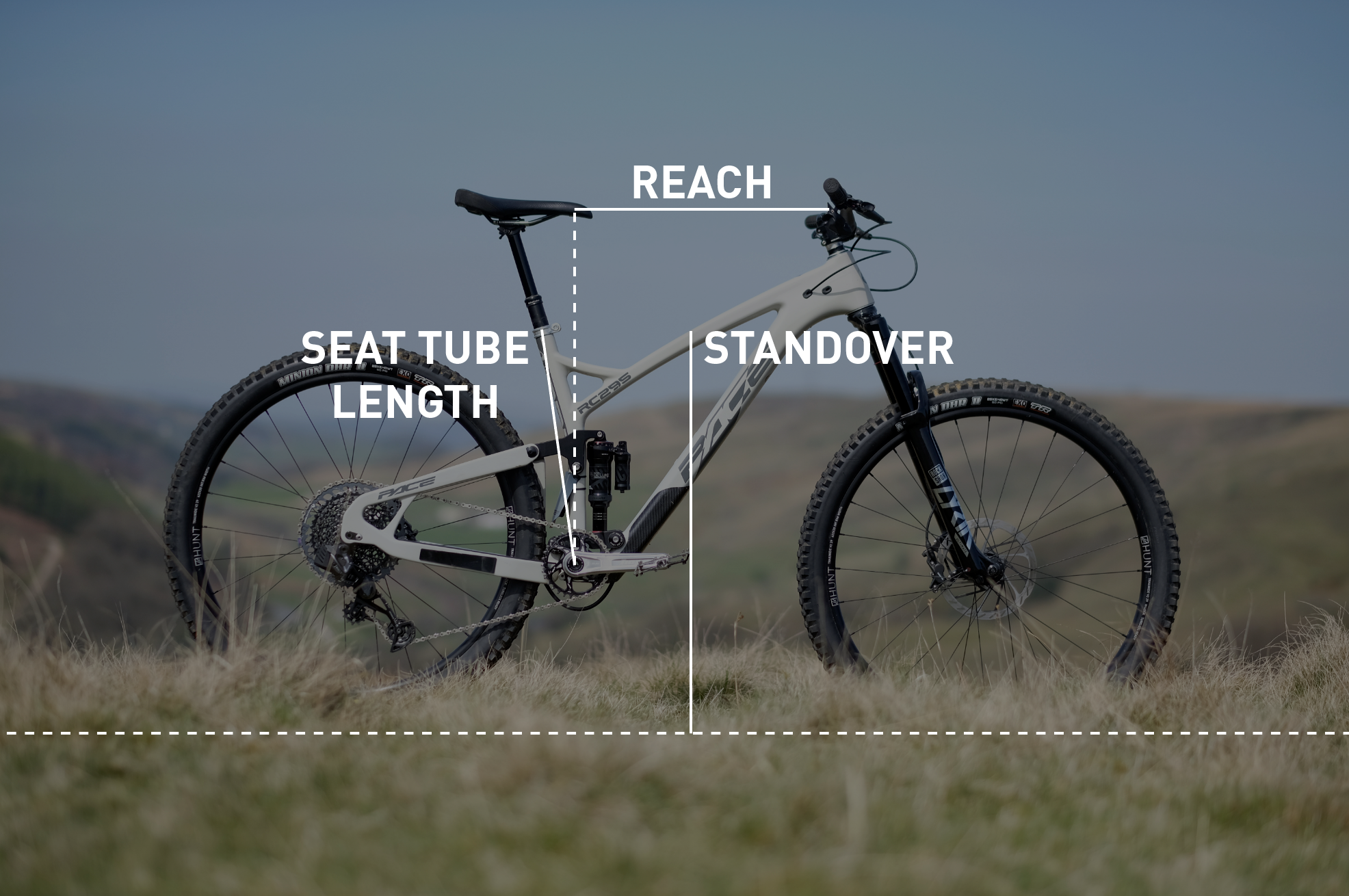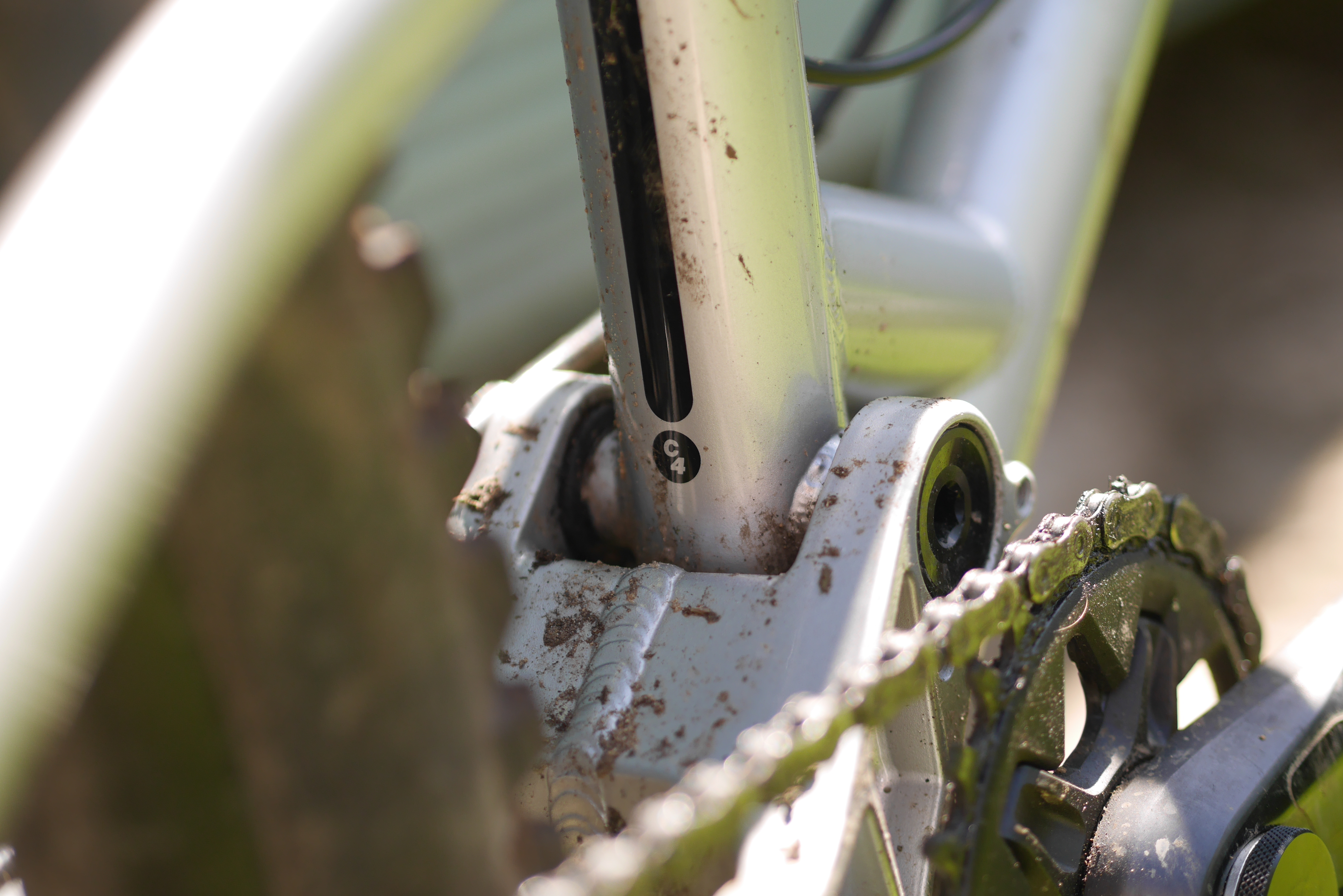If you’re unsure as to what size mountain bike to get, don’t worry. You’re not alone. It is not always obvious these days. Here is our easy-as-possible advice for ending up on the best size bike for you.
If you just want to make it as quick and straightforward as possible, check out the ‘Recommended frame size for rider height‘ list below. It will *probably* be fine.

Recommended frame size for rider height
- Under 5ft 2in (1257cm) = Extra Small (XS)
- 5ft 2in to 5ft 6in (157cm to 167cm) = Small (S)
- 5ft 6in to 5ft 10in (167cm to 178cm) = Medium (M)
- 5ft 10in to 6ft 2in (178cm to 188cm) = Large (L)
- 6ft 2in or above (188cm+) = Extra Large (XL)
If you want to make absolutely sure you’re going to get the most suitable size bike for you, you need to read this whole guide and factor in the seat tube length and reach number lists too.
Recommended maximum seat tube length for rider height
- Under 5ft 2in (1257cm) = 400mm max
- 5ft 2in to 5ft 6in (157cm to 167cm) = 400mm max
- 5ft 6in to 5ft 10in (167cm to 178cm) = 440mm max
- 5ft 10in to 6ft 2in (178cm to 188cm) = 480mm max
- 6ft 2in or above (188cm+) = 520mm max
Recommended reach numbers for rider height
- Under 5ft 2in (157cm) = 410mm to 450mm
- 5ft 2in to 5ft 6in (157cm to 167cm) = 430mm to 470mm
- 5ft 6in to 5ft 10in (167cm to 178cm) = 450mm to 490mm
- 5ft 10in to 6ft 2in (178cm to 188cm) = 470mm to 510mm
- 6ft 2in or above (188cm+) = 490mm to 530mm

Though arguably more complex than ever, bicycle sizing is better than it was. Thankfully almost every mountain bike brand has abandoned seat-tube measurement-based size names (17in, 19in, 21in etc).
Some brands have even forgone Small/Medium/Large nomenclature, instead using proprietary sizing names (Specialized’s S-number or Cotic’s C-number sizings for example).
Anyhow, frame sizing is still not without potential pitfalls.
Choose your advice carefully

You can go on the bike brand’s website, navigate to the bike that you’re interested in and have a look at their recommended frame sizing.
And do you know what? It will probably be fine.
But sometimes it won’t be.
Truth be told, some brands (and bike shops, and riding buddies) still give slightly outdated advice when it comes to frame size.
Things have changed over the past few years in mountain bike sizing. A lot of folk are now on bikes that are the size up from what they used to ride eg. now riding a Large instead of a Medium.
Also, people of the same height can have vastly varying leg/torso/arm dimensions.
In-betweeny

People can fall between frame sizes. Arguably the most common example of this is riders who are caught between Medium and Large size frames.
Fundamentally, it is kinda possible to make slightly-too-big bikes fit you, but there’s not a lot that can be salvaged if you end up on a bike that’s slightly-too-small.
If you find yourself struggling to choose between two frame sizes, go for the larger one.
You can tweak large bikes’ fit by swapping in a shorter stem and/or banging the saddle forward on its rails in the seatpost clamp. A decent bike shop will help you sort this out.
Putting on a longer stem and sliding a saddle back on its rails will make it handle worse, both uphill and downhill.
Beware the discounted deal

Don’t be tempted into getting a too-small bike because the price is right. Bikes that are too small suck. They aren’t “more playful and chuckable”, they’re unstable and uncomfortable.
Having said that, if you think the larger of the two frame sizes may not offer the standover that you require. Er. Tough. You need to look at a whole new bike/brand. Sorry!
It’s totally never worth ending up with the wrong size bike.
Reach and seat tube

Essentially when choosing a frame size, you’re going to have to get used to dealing with two measurements: Reach and Seat Tube Length.
Seat Tube Length is self-explanatory. Seat tube length heavily dictates something called ‘standover’. Standover is how high the top tube is at the point where you’re astride your bike with your feet on the floor.
However, standover is not really to do with casually straddling your bike. Standover is about being able to stop/bail/dismount should you find yourself getting into difficulty.
Logically, standover shouldn’t really matter because when you’re actually riding, your crotch is nowhere near the top tube. But if you’ve even ridden a bike with minimal standover you know how much it preys on your mind and damages your confidence and commitment on tricky sections (uphill and downhill).
Ultimately, the shorter the seat tube, the better.
Why don’t we have list of recommended standover measurements then? Because there isn’t much of a consensus or consistency amongst bike brands as how/where to measure standover from. So any list would be less-than-helpful. Sorry!
Reach is key

Reach then. Reach is the horizontal distance between the BB and the head tube.
Why is reach so important? Reach governs how the bike actually fits you. Reach cannot be adjusted. A bike with too short a reach will always be too small.
In a nutshell, we recommend getting the largest frame size that still gives you decent standover from a shorter seat tube length.
Of course, there’s more to bike sizing than what we can cover here (things like stack, chainstay length and so on) but it’s important to point out that it’s probably a wise move to look into the science of sizing before you splash the cash.
Here’s our Holy Trinity of mountain bike frame sizing again…
Recommended frame size for rider height
- Under 5ft 2in (1257cm) = Extra Small (XS)
- 5ft 2in to 5ft 6in (157cm to 167cm) = Small (S)
- 5ft 6in to 5ft 10in (167cm to 178cm) = Medium (M)
- 5ft 10in to 6ft 2in (178cm to 188cm) = Large (L)
- 6ft 2in or above (188cm+) = Extra Large (XL)
Recommended maximum seat tube length for rider height
- Under 5ft 2in (1257cm) = 400mm
- 5ft 2in to 5ft 6in (157cm to 167cm) = 400mm
- 5ft 6in to 5ft 10in (167cm to 178cm) = 440mm
- 5ft 10in to 6ft 2in (178cm to 188cm) = 480mm
- 6ft 2in or above (188cm+) = 520mm
Recommended reach numbers for rider height
- Under 5ft 2in (157cm) = 410mm to 450mm
- 5ft 2in to 5ft 6in (157cm to 167cm) = 430mm to 470mm
- 5ft 6in to 5ft 10in (167cm to 178cm) = 450mm to 490mm
- 5ft 10in to 6ft 2in (178cm to 188cm) = 470mm to 510mm
- 6ft 2in or above (188cm+) = 490mm to 530mm

Join our mailing list to receive Singletrack editorial wisdom directly in your inbox.
Each newsletter is headed up by an exclusive editorial from our team and includes stories and news you don’t want to miss.





